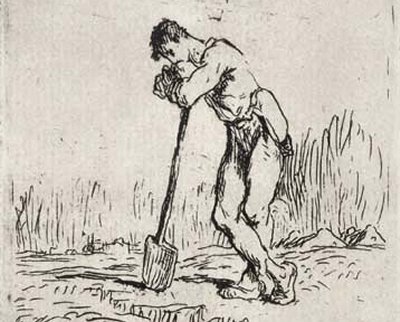Let us consider the plight of the lowly ditch
digger, the stereotypical example of the unskilled laborer. He is barely literate and so bereft of other talents that
he is probably unemployable in any other vocation—or at least
that’s the way many of us treat him. What is to become of such
a marginal worker in our modern globalized economy?
“We must help the
poor ditch digger,” says the altruist. “Society should provide him
with food, housing, and medical care, so he can live in good
health and security. We can’t let the wretch starve to death on
the street while others live in luxury and dine upon the finest
fare! Everyone must sacrifice to save this poor soul from
himself.”
“No, no!” replies the interventionist. “Instead, the government should pay him to dig ditches and fill them in again. The money he spends will stimulate economic activity. No new goods or services will be produced, since we’ll only be moving resources around, but everyone will be employed.”
“No, no!” replies the interventionist. “Instead, the government should pay him to dig ditches and fill them in again. The money he spends will stimulate economic activity. No new goods or services will be produced, since we’ll only be moving resources around, but everyone will be employed.”
“I have a better
idea,” offers the capitalist. “I could employ several ditch
diggers on my construction projects. Their labor would add real
value to my investments! I would pay them small wages, but they
would enjoy honest remuneration, the dignity of productive
work, and the opportunity to learn new workplace skills and
advance their careers. If my investments succeed, there will be
more goods and services available, and everyone will grow a
little bit wealthier, including the ditch diggers.”
“You can’t pay him
small wages!” the altruist says in horror. “How would he support
his wife and children on such a pittance?”
“The ditch digger
needs a fair wage—a living wage,” the interventionist adds. “The
government should mandate minimum wages that guarantee workers
won’t live in poverty.”
“Frankly,” the capitalist responds, “his labor
isn’t worth more than that. If higher wages were mandated, I
would be better off dismissing the ditch diggers from my employ
and acquiring mechanized entrenching equipment to enhance the
productivity of my more skilled workers. The ditch diggers will
be out of work, my projects will be a little less profitable,
and we’ll all be little bit less well off than we might have
been.”
“Have you no heart?” laments the altruist. “Will you let the poor ditch digger suffer and perish for your greed?”
“I certainly do have a heart!” retorts the capitalist. “When I can, I donate to charitable organizations that support the victims of disaster and indigence. You do the same, I’m sure.”
“Well …” the altruist hesitates. “I pay my taxes.”
“Indeed!” the interventionist says. “Contribution must be mandatory in order to maintain the public welfare in an equitable manner.”
“Don’t
worry,” a politician slyly interjects. “I can fix everything.
I’ll write laws setting a minimum wage for all workers and
providing food stamps, housing vouchers, and free health
insurance for the unemployable. Of course, we’ll have to levy
higher taxes or borrow money to pay for all these benefits.
Grateful for the public largesse, the people will reward me with
their votes, and I will win re-election!”
“You do realize what
will happen?” asks the capitalist. “Costs will rise throughout
the market until the buying power of the higher wages has been
reduced to their real value. Meanwhile, the ditch diggers and many other unskilled workers
will be driven from the workforce. Some will never return,
permanently relying on public benefits for their survival. In
other words, your policies will actually perpetuate
poverty!”
“So
much the better!” enthuses the politician. “I can legislate for
higher wages and increased public benefits again and again. I’ll have those ditch diggers voting for my party for the next 200 years.”
So what will become of the benighted ditch digger? Will he be allowed to contribute his value, however meager, to the economy at large and to share in the concomitant opportunity for advancement toward prosperity? Or will he be consigned to live in unemployment and relative poverty forever—or at least until other people’s money runs out?
So what will become of the benighted ditch digger? Will he be allowed to contribute his value, however meager, to the economy at large and to share in the concomitant opportunity for advancement toward prosperity? Or will he be consigned to live in unemployment and relative poverty forever—or at least until other people’s money runs out?





